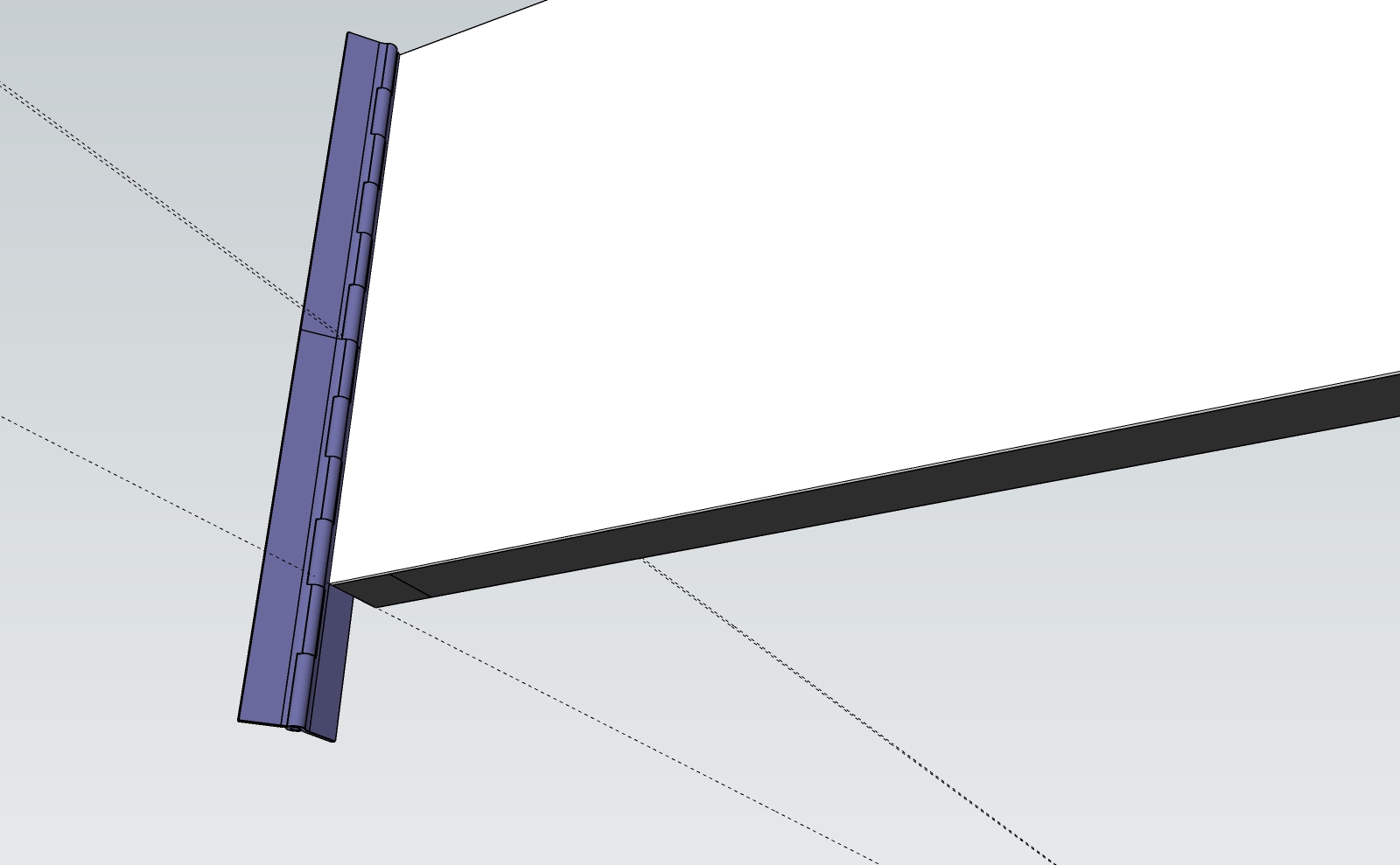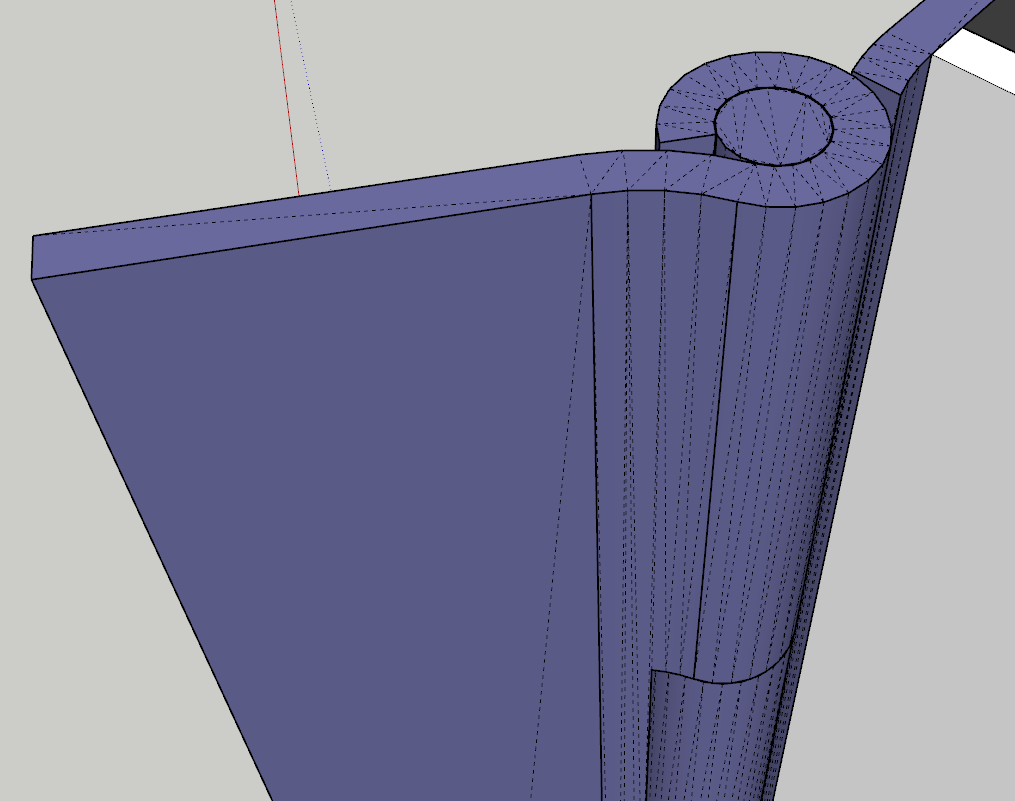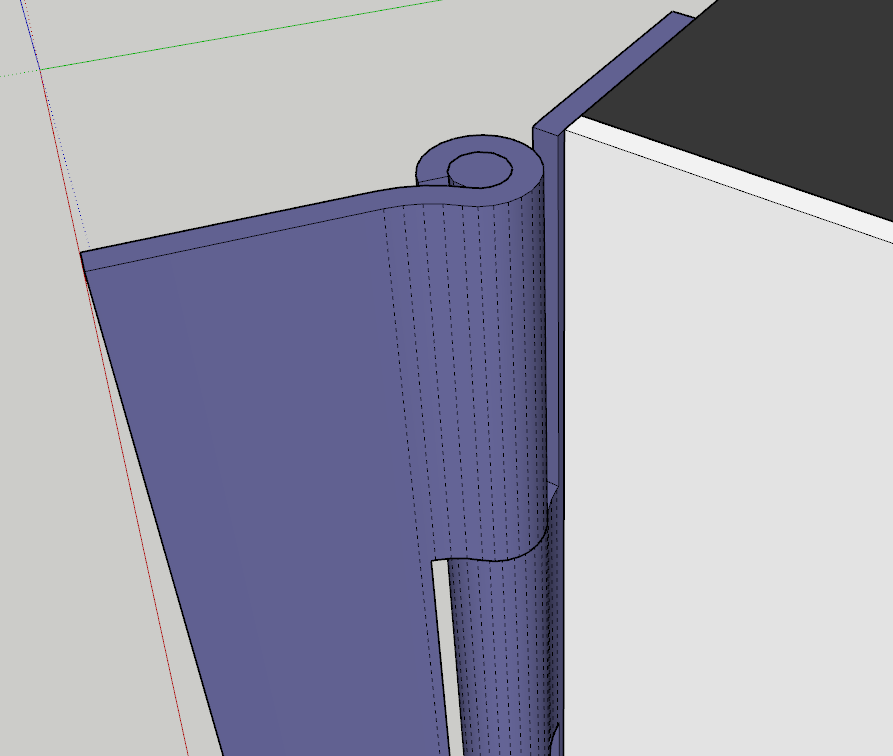Trim a piano hinge to length. Converted STP file
-
I'm trying to trim a hinge to length for a door.
The hinge was a download from McMaster Carr in STP format and converted using Sim Lab Step Importer extension.
The hinge is only 12" long and I need 1'-7.75". So I copied the hinge along the frame and now need to trim the hinge to fit.
The hinge is not a solid according to Sketchup as I cannot use any of the Solid Tool operations to trim to length.
Is there a Plug in for this or a way to convert the hinge to a solid?I come from many years of experience in CAD and Catia and I get frustrated in Sketchup with things that seems so simple to accomplish in other modeling software. Hoping there is a simple way to make this happen that I just haven't stumbled across yet.

-
I would look at the export options in your file conversion tool.

Your object is a collection of grouped objects. Grouped geometry in SketchUp separate/isolate geometry so it does not merge.
Use outliner to get an overview of your objects structure.

Also STP files are NURBS based geometry and SketchUp is not NURBS based so there's that to deal with too.
I wouldn't say the problem is SketchUp it is more the original file format.
It is likely quicker to model the hinge in SketchUp than to try and untangle that imported file.
-
If you just want to chop the hinge off like you would in real life with a hacksaw, the Plugin Zorro adds a slice tool to the section plane.

-
In addition to the comments made by Rich I would suggest looking at the hidden geometry. Your imported hinge component has a lot of unneeded geometry that could be eliminated.

That hinge is so simple I just redrew it starting with a cleaned up copy of the top edge component but there are extensions that could be used to do the cleaning after exploding all those unneeded sub-components. I also drew it as a continuous hinge instead of a couple of short sections. This reduced the entity count in the hinge by 64%.

The hasp on the other side of the door could use similar treatment. In this model that isn't a huge deal but in more complex models that sort of cleanup would have a huge impact. After cleaning up the hasp the total file size is reduced by more than 46%.
DOOR-COMPLETE 1 - OPEN reworked hinge.skp -
You all rock! Thank you.
I'm finding it hard to find hardware/materials that will import into Sketchup easily. Most things seems to be IGES, STP or SLDPRT. The SimLab is the first converter I found so I went with it.
Its odd for me to go after plugins/extensions and not have everything native to the program so I'm getting used to that.
-
I need to learn the Outliner. Thanks for the comments.
@rich o brien said:
I would look at the export options in your file conversion tool.

Your object is a collection of grouped objects. Grouped geometry in SketchUp separate/isolate geometry so it does not merge.
Use outliner to get an overview of your objects structure.

Also STP files are NURBS based geometry and SketchUp is not NURBS based so there's that to deal with too.
I wouldn't say the problem is SketchUp it is more the original file format.
It is likely quicker to model the hinge in SketchUp than to try and untangle that imported file.
-
Dave, could you suggest plugins that will do this? I did some quick searching when I was getting these files but did come up with one.
Thanks for the massaged file as well.
@dave r said:
In addition to the comments made by Rich I would suggest looking at the hidden geometry. Your imported hinge component has a lot of unneeded geometry that could be eliminated.
[attachment=2:umzymitb]<!-- ia2 -->Screenshot - 11_16_2021 , 4_30_09 AM.png<!-- ia2 -->[/attachment:umzymitb]That hinge is so simple I just redrew it starting with a cleaned up copy of the top edge component but there are extensions that could be used to do the cleaning after exploding all those unneeded sub-components. I also drew it as a continuous hinge instead of a couple of short sections. This reduced the entity count in the hinge by 64%.
[attachment=1:umzymitb]<!-- ia1 -->Screenshot - 11_16_2021 , 4_44_53 AM.png<!-- ia1 -->[/attachment:umzymitb]The hasp on the other side of the door could use similar treatment. In this model that isn't a huge deal but in more complex models that sort of cleanup would have a huge impact. After cleaning up the hasp the total file size is reduced by more than 46%.
[attachment=0:umzymitb]<!-- ia0 -->DOOR-COMPLETE 1 - OPEN reworked hinge.skp<!-- ia0 -->[/attachment:umzymitb] -
Thanks, I'll check this one out. Does it actually slice it and remove or just hide it below the section plane?
@box said:
If you just want to chop the hinge off like you would in real life with a hacksaw, the Plugin Zorro adds a slice tool to the section plane.
-
First, when I need to have SketchUp models of hardware like your hinge and door hasp, I prefer to either use the 2D CAD files (McMaster-Carr offers them for many of the items they sell) or I will work from a dimensioned drawing. I create the component with as little detail as I can get away with and still communicate what it is. Since these are not objects that I'll be creating manufacturing drawings for, there's no real benefit in adding lots of detail. The more detail you add the larger the file becomes and the more work your computer has to do to deal with it.
I'd expect that your hinge, for example, doesn't really need a pin. Maybe the hasp doesn't need the hinge portion on the back.
Now, before extensions, the first thing I do is look closely at the geometry. Turning on Hidden Geometry helps because it shows stuff like all those softened edges I showed in the screen shot. I also work with the Face Style set to Monochrome so I can identify and fix reversed faces.
Then as far as extensions go, there's Thom Thom's CleanUp3 and Solid Inspector2. There's also Fixit. Look in the Sketchucation Plugin Store.
FWIW, I often hear people say they don't want to spend the time creating components but they usually spend much more time fixing up components made by others to make them usable or waiting for their computer to complete some task due to the obese components someone else made. I'd rather put in a few minutes up front and make a good component than waste the time fixing what somone else did or dealing with objects imported from other software.
FWIW, if you use 2D .dxf or .dwg files in SketchUp, use them as references but draw your own geometry.
Advertisement







